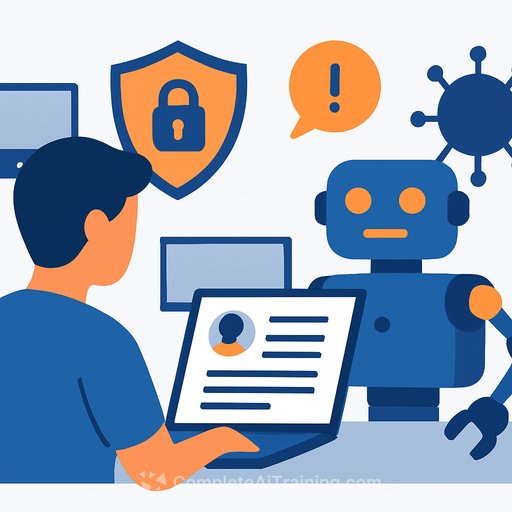AI + Ubiquitous Tech = a National Security Risk Multiplier
AI is no longer a hypothetical risk. OpenAI publicly documented 10 campaigns in June 2025 that used generative tools for coordinated cyber, espionage, and influence operations by China, Russia, North Korea, and Iran. When AI meets always-on tech, threats don't slowly grow-they compound.
For Operations leaders, this is an execution problem. Your devices, your hiring pipeline, and your comms channels are now active targets-and often the entry point.
Ubiquity Means Vulnerability
Smartphones, cloud apps, biometric logins, and collaboration tools create a constant connection. That convenience expands the surface area for intrusion and influence. With generative AI, even small threat actors can scale across devices, apps, and identities in seconds.
They blend in with tone-matched language, culturally fluent personas, and algorithmically boosted content that reads as real. The net effect: faster operations against your processes with less detectable friction.
Three Ops Case Studies: Propaganda, Intrusion, Identity Subversion
Operation "Sneer Review" (China): AI-generated personas across TikTok and X amplified pro-Beijing narratives. The network looked global, but was centrally controlled-classic information laundering, accelerated by AI.
"ScopeCreep" (Russia): ChatGPT-assisted development and troubleshooting of Windows-based malware, including a Telegram alert function. AI supported both build and operations.
Resume Espionage (North Korea): Mass-produced AI resumes targeted remote tech jobs to secure employer-issued hardware and virtual access. It's insider threat tactics rebuilt for distributed work.
What This Means for Operations
AI isn't just a tool-it's a threat surface that touches hiring, devices, identity, and influence. Treat everyday workflows as potential collection and access vectors.
- Verify beyond the resume: Assume profiles and portfolios can be AI-generated. Build verification into screening, not after onboarding.
- Rethink endpoint assumptions: Credentialed access is the new breach path. Treat day-one devices and remote tools as live risks.
- Report unusual digital behavior: Repetition, manufactured consensus, and "too-slick" personas are signals. Escalate early.
90-Day Action Plan for Ops Teams
- Tighten talent screening: Use structured interviews, skills tests observed live, and reference calls to verified numbers. Compare writing samples across contexts for style drift.
- Harden endpoints on day one: Enforce MDM and EDR, least-privilege by default, and VDI for contractors. Disable removable media and risky macros; enable geo/temporal login alerts.
- Consolidate SaaS access: Route apps through SSO, enforce MFA, and log all admin actions. Disable unnecessary AI features and restrict model file uploads.
- Identity and device trust: Apply conditional access, device compliance checks, and just-in-time privileges. Review local admin rights weekly.
- Influence monitoring: Establish lightweight brand/persona monitoring. Create a takedown and escalation workflow for coordinated narratives or bot-like engagement.
- Data controls: Classify data, enforce DLP, and block copy/paste from sensitive apps to unmanaged contexts. Require code signing for production changes.
- Run adversarial drills: Red-team a fake candidate, a social botnet push, and a malware callback test. Measure time-to-detect and time-to-revoke.
- Playbooks and training: Add modules for deepfake voice, AI phishing, and suspicious resumes. Define who to call, what to collect, and how to isolate assets in the first hour.
Detection Tells Worth Your Attention
- Resumes that are flawless yet generic; inconsistent timelines or recycled achievements.
- Interview answers that are over-polished and lack personal anecdotes or specific failure stories.
- Portfolios with perfect but context-free case studies; Git history that appears bulk-uploaded or lacks meaningful commit messages.
- New social accounts with sudden traction and repetitive phrasing; cross-platform posting at odd hours for the claimed locale.
- Coordinated messaging waves that repeat framings, not facts, across multiple "individuals."
KPIs Ops Should Track
- Resume-to-hire verification failure rate.
- Percent of contractors on VDI and non-persistent desktops.
- New endpoints flagged in first 14 days; time-to-revoke compromised credentials.
- Percent of SaaS apps behind SSO + MFA; weekly admin action audits completed.
- Monthly count of influence or impersonation incidents and time-to-takedown.
Raise Tech Literacy Across the Floor
Brief every function touched by identity, access, and comms-HR Ops, IT Ops, SecOps, and vendor management. Make AI risk literacy part of onboarding and quarterly refreshers.
If your team needs structured upskilling on AI usage and safeguards, see role-based training options here: Complete AI Training: Courses by Job.
Recommended Resources
The Bottom Line
The AI arms race is here, and the battlefield is your inbox, your algorithm, and your identity. Treat AI-augmented threats as a daily operational reality. Verify people, instrument devices, and react fast.
Your membership also unlocks:






